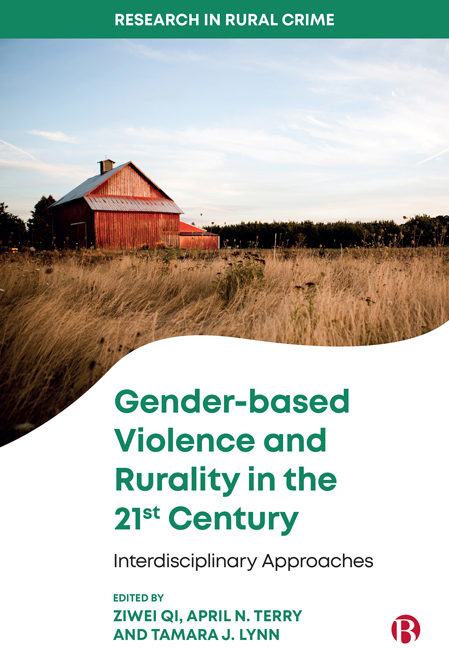Book contents
- Frontmatter
- Contents
- Series Preface
- List of Figures and Table
- List of Abbreviations
- Glossary
- Notes on Contributors
- Foreword
- 1 Understanding Rurality and Gender-based Violence
- PART I Rurality and Gender-based Violence
- PART II Beyond the Rural/Urban Divide: Critical Issues in Gender-based Violence
- PART III Access to Rural Justice: Economic Consequences and Policy Implications
- Index
5 - College Students’ Perceptions of Interpersonal Violence
Published online by Cambridge University Press: 20 January 2024
- Frontmatter
- Contents
- Series Preface
- List of Figures and Table
- List of Abbreviations
- Glossary
- Notes on Contributors
- Foreword
- 1 Understanding Rurality and Gender-based Violence
- PART I Rurality and Gender-based Violence
- PART II Beyond the Rural/Urban Divide: Critical Issues in Gender-based Violence
- PART III Access to Rural Justice: Economic Consequences and Policy Implications
- Index
Summary
Introduction
Interpersonal violence is a common issue around the globe. Per a study conducted by the World Health Organization (WHO, 2021) from 2000 to 2018 – focusing on women and girls, from 161 countries, aged 15 years and older – one in three women have experienced violence at least once during their lifetime, and approximately 25 per cent of women in the United States have experienced violence. Estimates of interpersonal violence victimisation in rural areas are similar to estimates in urban spaces, while some studies suggest higher rates of victimisation within rural communities (Breiding et al, 2009) due to the emphasis on informal social controls (Carrington, 2007) specific to rural culture (Rennison et al, 2013).
Approximately 5.3 million females and 3.2 million males report experiencing physical abuse each year (Park and Kim, 2019). Reportedly, 20– 30 per cent of college students fall victim to varying forms of violence (Ameral et al, 2020) for reasons related to socialisation, relationship conflict, substance use, limited problem-solving skills, among others (Cranney, 2015; Giordano et al, 2020). These statistics likely go underreported for several reasons, including a limited understanding of what constitutes violence by college students (Elmquist et al, 2016 ), and in rural locations, less willingness to help survivors as an attempt to ‘mind one's own business’ (Donnermeyer, 2015). This chapter seeks to understand college students’ perceptions of interpersonal violence through use of video vignettes portraying various forms of interpersonal violence. Furthermore, the chapter aims to find whether educational programmes influence these perceptions. This information is important for supporting higher learning institutions in responding to and reducing Title IX issues on college campuses, which ‘protects students from sexual harassment in educational programs or activities’ (Title IX of the Education Amendments of 1972, 20 U.S.C. §1681).
Defining and understanding perceptions of interpersonal violence
The World Health Organization defines interpersonal violence as ‘any behaviour within an intimate relationship that causes physical, psychological, or sexual harm’ (WHO, 2012: 1). Physical violence includes more recognisable acts of violence such as beating, hitting, kicking and slapping (WHO, 2012). Psychological harm, often referred to as emotional abuse, is described as attitudes, behaviours and verbal aggression that controls, dominates, humiliates, intimidates or threatens a partner (Jennings et al, 2017). Sexual violence includes ‘forced sexual intercourse and other forms of sexual coercion’ (WHO, 2012: 1).
- Type
- Chapter
- Information
- Gender-based Violence and Rurality in the Twenty-first CenturyInterdisciplinary Approaches, pp. 57 - 74Publisher: Bristol University PressPrint publication year: 2023



